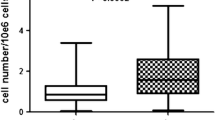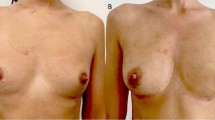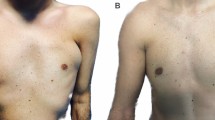Abstract
The use of adipose tissue transfer in plastic and reconstructive surgery is not new and has been studied extensively. Due to different results with regard to adipose cell damage and the level of survival of the transferred tissue in clinical practice, the authors aimed to investigate the effects of centrifugation on fat aspirates to optimize the centrifugal force for fat transplantation and to obtain an increased number of intact adipose progenitor cells. The following different centrifugation forces were evaluated in vitro in terms of fat decantation: 3,000 rpm (1,500×g), 1,300 rpm (250×g), and 500 rpm (50×g). Moreover, the density level, morphology of fat cells, cell viability, and progenitor cell number also were evaluated. Centrifugation leads to a good fat tissue density, with a significant number of progenitor cells, and efficiently removes the liquid portion. High centrifugal forces (at 3,000 rpm) caused significant damage to fat cells with low cell viability, whereas very low centrifugal forces (at 500 rpm) showed little effect on adipose tissue density, resembling fat decantation. Fat aspirates, withdrawn from 30 healthy donors in vivo, were centrifuged at different rotations per minute (rpm), as follows. For the 10 patients in group A, Coleman’s technique was used with a centrifugation of the aspirated fat at 3,000 rpm (1,500×g) for 3 min. For the 10 patients in group B, the authors’ technique was used, with centrifugation of the aspirated fat at 1,300 rpm (250×g) for 5 min. For the 10 patients in group C, simple decantation of fat was used. In conclusion, a centrifugal force of 1,300 rpm resulted in better density of adipose tissue, with good cell viability and increased ability to preserve a significant number of progenitor cells.





Similar content being viewed by others
References
Neuber GA (1893) Fettransplantation. Verh Dtsch Ges Chir 22:66
Lexer E (1910) Freire fettgewebstranplantation. Dtsch Med Wochenschr 36:46
Bruning P. Cited by Broeckaert TJ, Steinhaus J (1914) Contribution e l’etude des greffes adipueses. Bull Acad Roy Med Belgique 28:440
Peer LA (1950) Loss of weight and volume in human fat grafts. Plast Reconstr Surg 5:217
Peer LA (1956) The neglected free fat graft. Plast Reconstr Surg 18:233
Gurney CE (1937) Studies on the fate of free transplants of fat. Proc Staff Meet Mayo Clin 12:317
Illouz YG (1986) The fat cell graft: a new technique to fill depressions. Plast Reconstr Surg 78:122
Illouz YG (1988) Present results of fat injection. Aesthetic Plast Surg 12:175–181
Fournier PF (1985) Microlipoextration et microlipoinjection. Rev Chir Esthet Lang Franc 10:36–40
Pinski KS, Roenigk HH Jr (1992) Autologous fat transplantation. Long-term follow-up. J Dermatol Surg Oncol 18:179–184
Matsudo PK, Toledo LS (1988) Experience of injected fat grafting. Aesthetic Plast Surg 12:35–38
Elenbogen R (2000) Fat transfer: current use in practice. Clin Plast Surg 27:545–556
Horl HW, Feller AM, Biemer E (1991) Technique for liposuction fat reimplantation and long-term volume evaluation by magnetic resonance imaging. Ann Plast Surg 26:248–258
Sadick NS, Hudgins LC (2001) Fatty acid analysis of transplanted adipose tissue. Arch Dermatol 137:723–727
Coleman SR (1995) Long-term survival of fat transplants: controlled demonstrations. Aesthetic Plast Surg 19:421–425
Coleman SR (1997) Facial recontouring with lipostructure. Clin Plast Surg 24:347
Boschert MT, Beckert BW, Puckett CL, Concannon MJ (2002) Analysis of lipocyte viability after liposuction. Plast Reconstr Surg 109:761
Butterwick KJ (2002) Lipoaugmentation for aging hands: a comparison of the longevity and aesthetic results of centrifuged versus noncentrifuged fat. Dermatol Surg 28:987–991
Kurita M, Matsumoto D, Shigeura T, Sato K, Gonda K, Harii K, Yoshimura K (2008) Influences of centrifugation on cells and tissues in liposuction aspirates: optimized centrifugation for lipotransfer and cell isolation. Plast Reconstr Surg 121:1033–1041
Shiffman MA (2000) Effect of various methods of fat harvesting and reinjection. Am J Cosmet Surg 17:91
Shiffman MA, Mirrafati S (2001) Fat transfer techniques: the effect of harvest and transfer methods on adipocyte viability and review of the literature. Dermatol Surg 27:819–826
Coleman SR (2006) Structural fat grafting: more than a permanent filler. Plast Reconstr Surg 118:108S
D’Andrea F, De Francesco F, Ferraro G, Desiderio V, Tirino V, Papaccio G (2008) Large-scale production of human adipose tissue from stem cells: a new tool for regenerative medicine and tissue banking. Tissue Eng Part C Methods 14:233–242
Chajchir A, Benzaquen I (1989) Fat-grafting injection for soft tissue augmentation. Plast Reconstr Surg 84:921–935
Niechajev I, Sevcuk O (1994) Long-term results of fat transplantation: clinical and histologic studies. Plast Reconstr Surg 94:496–506
Glasgold M, Lam SM, Glasgold R (2007) Autologous fat grafting for cosmetic enhancement of the perioral region. Facial Plast Surg Clin North Am 15:461–470
Nelson L, Stewart KJ (2008) Experience in the treatment of HIV-associated lipodystrophy. J Plast Reconstr Aesthet Surg 61:366–371
Pinsolle V, Chichery A, Grolleau JL, Chavoin JP (2008) Autologous fat injection in Poland’s syndrome. J Plast Reconstr Aesthet Surg 61:784–791
Pereira LH, Sterodimas A (2008) Free fat transplantation for the aesthetic correction of mild pectus excavatum. Aesthetic Plast Surg 32:393–396
Caviggioli F, Klinger F, Villani F, Fossati C, Vinci V, Klinger M (2008) Correction of cicatricial ectropion by autologous fat graft. Aesthetic Plast Surg 32:555–557
Klinger M, Marazzi M, Vigo D, Torre M (2008) Fat injection for cases of severe burn outcomes: a new perspective of scar remodeling and reduction. Aesthetic Plast Surg 32(3):465–469
de Souza Kruschewsky L, de Mello-Filho FV, Saggioro F, Serafini LN, Rosen CA (2007) Histologic study of an autologous fat graft in the larynx of dogs with unilateral vocal fold paralysis. Laryngoscope 117:2045–2049
Shoshani O, Berger J, Fodor L, Ramon Y, Shupak A, Kehat I, Gilhar A, Ullmann Y (2005) The effect of lidocaine and adrenaline on the viability of injected adipose tissue—an experimental study in nude mice. J Drugs Dermatol 4:311–316
Ullmann Y, Hyams M, Ramon Y, Beach D, Peled IJ, Lindenbaum ES (1998) Enhancing the survival of aspirated human fat injected into nude mice. Plast Reconstr Surg 101:1940–1944
Sommer B, Dsttler G (2000) Current concepts of fat graft survival: histology of aspirated adipose tissue and review of the literature. Dermatol Surg 26:1159–1166
Sajjadian A, Tandav Magge K (2007) Treating facial soft tissue deficiency: fat grafting and adipose-derived stem cell tissue engineering. Aesthetic Surg J 27:100–104
Huss FR, Kratz G (2002) Adipose tissue processed for lipoinjection shows increased cellular survival in vitro when tissue engineering principles are applied. Scand J Plast Reconstr Surg Hand Surg 36:166–171
De Francesco F, Tirino V, Desiderio V, Ferraro G, D’Andrea F, Giuliano M, Libondi G, Pirozzi G, De Rosa A, Papaccio G (2009) Human CD34+/CD90+ ASCs are capable of growing as sphere clusters, producing high levels of VEGF and forming capillaries. PLoS ONE 4:e6537
Acknowledgments
The authors thank Gianpaolo Papaccio, Department of Experimental Medicine, Section of Histology and Embryology, Second University of Naples, for his suggestions, criticisms, and laboratory technical support. The authors also thank Giuseppe Pirozzi, Department of Experimental Oncology, Section of Cellular Biology and Biotherapy, INT “Pascale,” for flow cytometry and apoptosis assays.
Conflict of interest
All authors declare that they have no actual or potential conflict of interest including any financial, personal or other with other people or organizations.
Author information
Authors and Affiliations
Corresponding author
Rights and permissions
About this article
Cite this article
Ferraro, G.A., De Francesco, F., Tirino, V. et al. Effects of a New Centrifugation Method on Adipose Cell Viability for Autologous Fat Grafting. Aesth Plast Surg 35, 341–348 (2011). https://doi.org/10.1007/s00266-010-9613-8
Received:
Accepted:
Published:
Issue Date:
DOI: https://doi.org/10.1007/s00266-010-9613-8




